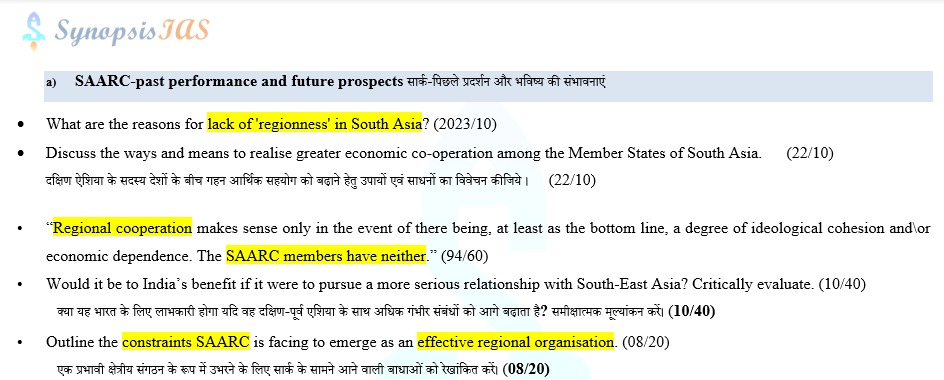PSIR 5b. What are the reasons for lack of 'regionness' in South Asia UPSC 2023, 10 Marks
South Asia, despite its geographical proximity and shared history, has struggled to achieve a sense of 'regionness.'

Introduction
South Asia, despite its geographical proximity and shared history, has struggled to achieve a sense of 'regionness.' Several factors contribute to this lack of regional cohesion and integration:
1. Historical Animosities:
Colonial Legacy: The region was divided during the British colonial era into separate entities, leading to territorial disputes and historical grievances.
Partition of India: The partition of India in 1947 resulted in one of the world's largest migrations and created enduring tensions between India and Pakistan.
2. Bilateral Conflicts:
India-Pakistan Rivalry: The ongoing rivalry between India and Pakistan over issues like Kashmir has prevented meaningful regional cooperation.
India-China Border Disputes: The unresolved border issues between India and China have strained regional relations.
3. Political Instability:
Frequent Regime Changes: Political instability and frequent changes in leadership in some South Asian countries have hindered long-term regional planning.
4. Economic Disparities:
Economic Imbalance: There are significant economic disparities among South Asian countries, leading to concerns about unequal benefits in regional cooperation.
5. Security Concerns:
Security Threats: South Asia faces various security challenges, including terrorism, insurgency, and communal violence, which divert resources away from regional cooperation.
6. Diverse Cultures and Languages:
Cultural and Linguistic Diversity: South Asia is incredibly diverse in terms of cultures, languages, and religions, making it challenging to create a shared regional identity.
7. Lack of Infrastructure:
Poor Connectivity: Insufficient infrastructure and connectivity hinder the movement of people, goods, and services within the region.
8. Limited Trust:
Lack of Trust: Historical conflicts and unresolved issues have resulted in a lack of trust among South Asian countries.
9. External Influences:
Global Power Interests: The region has often been influenced by external powers' interests, which can undermine local efforts at cooperation.
10. Governance Challenges:
Governance Issues: Some South Asian countries face governance challenges, including corruption and political instability, which impede regional initiatives.
11. Non-State Actors:
Role of Non-State Actors: Militant and extremist groups operating across borders further complicate regional stability.
12. Absence of Effective Regional Organizations:
Limited Role of SAARC: The South Asian Association for Regional Cooperation (SAARC) has struggled to make significant progress due to bilateral conflicts and mistrust among members.
13. Competition for Resources:
Resource Scarcity: Competition for water resources, such as the Indus and Brahmaputra rivers, has led to tensions between riparian states.
14. Lack of Regional Vision:
Absence of Shared Vision: There is a lack of a common vision for the region, with countries often pursuing their individual interests rather than collective goals.
These complex and intertwined factors have contributed to the challenge of fostering a sense of 'regionness' in South Asia, making regional cooperation a persistent and intricate issue.